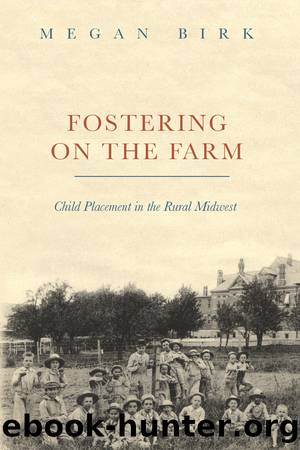Fostering on the Farm by Megan Birk

Author:Megan Birk [Birk, Megan]
Language: eng
Format: epub
Tags: History, General, United States, 20th Century, Family & Relationships, Adoption & Fostering
ISBN: 9780252097294
Google: nLVCCQAAQBAJ
Publisher: University of Illinois Press
Published: 2015-06-15T02:52:23+00:00
5. The Farm, the Federal Government, and the Decline of Placement
âThe farmer is a slave, and his wife is the slave of a slaveâ¦harp all you will about the pure airâ¦but account, if you can, for the generally stunted physical and mental growth of country children.â
âSarah Burns, Pastoral Inventions
Hastings Hart provided a blunt assessment of farm placement when he discussed how the farm affected children: âTake a boy of good parentage, with natural refinement, good features, small bones, small hands and feet; put that boy on a farm, where he will have to get up at five o'clock in the morning, milk five or six cows, attend a district school, with meager opportunities, and where he will be associated with people who lack refinement; and one of two things will happen: the boy will either deteriorate and go backward, or he will become discouraged and a complete failureâ¦place that boy in a village home and he will be a complete success.â The boy best suited for the farm, according to Hart, was âa rather dull and backward but strong and good natured boy.â The virtuous American farm, once the savior of dependent children, served only as a good refuge for children for whom proper schooling or intellectual stimulation would be a waste.1
In the scenario Hart laid out, the bright boy needed to stay in a good home with interesting influences; the dull but otherwise healthy boy could be placed on a farm; and children for whom a normal home would not do because of disability could stay in an institution. Crucial changes in the national discussion of child welfare helped push Hart's hypothetical scenario into a reality. The 1909 White House Conference on Dependent Children made prominent existing suggestions about the importance of family preservation, and in 1914, standards recommended by the National Conference for Charities and Corrections further accelerated the turn away from farm placement by suggesting multiple annual visits by placing agents, with an emphasis on homes ârestricted to distances within ready supervision of the organization legally responsible for the child.â2 States like Indiana had just managed to get children a visit at least once a year, so moving toward multiple visits would require a massive increase in resources. As one directive for placements explained, âFormerly it was supposed that nearly all the best available homes would be found on farms, and placement in towns and cities was not specially advocated or magnified. Experience has demonstrated that many of the best homes are in populous centers, and probably more children are now placed in towns and cities than on farms.â Paid foster homes ensured that homes within easy distances could be located and that the job of foster parent went to urban or suburban dwellers of the working class, where they remained into the twenty-first century.3
The increased amount of state and local regulation for the care of dependent children brought change to rural placement, first by increasing the supervision placed-out children received and then by reducing the number of placed-out children through family preservation, paid boarding, and specialized institutions.
Download
This site does not store any files on its server. We only index and link to content provided by other sites. Please contact the content providers to delete copyright contents if any and email us, we'll remove relevant links or contents immediately.
| Africa | Americas |
| Arctic & Antarctica | Asia |
| Australia & Oceania | Europe |
| Middle East | Russia |
| United States | World |
| Ancient Civilizations | Military |
| Historical Study & Educational Resources |
Machine Learning at Scale with H2O by Gregory Keys | David Whiting(4258)
Never by Ken Follett(3879)
Fairy Tale by Stephen King(3307)
The Man Who Died Twice by Richard Osman(3040)
Oathbringer (The Stormlight Archive, Book 3) by Brandon Sanderson(3015)
Will by Will Smith(2872)
Rationality by Steven Pinker(2326)
The Dark Hours by Michael Connelly(2278)
Can't Hurt Me: Master Your Mind and Defy the Odds - Clean Edition by David Goggins(2271)
Friends, Lovers, and the Big Terrible Thing by Matthew Perry(2182)
The Dawn of Everything: A New History of Humanity by David Graeber & David Wengrow(2156)
Principles for Dealing With the Changing World Order: Why Nations Succeed and Fail by Ray Dalio(2006)
HBR's 10 Must Reads 2022 by Harvard Business Review(1820)
A Short History of War by Jeremy Black(1815)
Go Tell the Bees That I Am Gone by Diana Gabaldon(1730)
A Game of Thrones (The Illustrated Edition) by George R. R. Martin(1660)
515945210 by Unknown(1642)
Kingdom of Ash by Maas Sarah J(1592)
443319537 by Unknown(1520)
